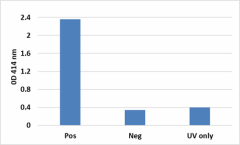- Regulatory Status
- RUO
- Other Names
- MHC tetramer, HLA tetramer, HLA monomer, MHC monomer

-

The bar graph shows ELISA results after peptide exchange on Flex-T™ HLA-A*24:02 monomer UVX. The UVX monomer was irradiated with UV light in the presence of a positive (Pos) or negative (Neg) peptide, or no peptide (UV only). The positive peptide is an HLA-A*24:02 epitope from Influenza virus (YYLEKANKI); the negative peptide is an HLA-A*02:01 epitope from CMV (NLVPMVATV).
| Cat # | Size | Price | Quantity Check Availability | ||
|---|---|---|---|---|---|
| 280019 | 50 µg | $1045.00 | |||
CD8+ T cells are essential components of the immune system. They function through TCR recognition of antigens (peptide epitopes) presented by the class I MHC (HLA in humans) molecules. Thus, TCR recognition of cognate MHC/peptide complex can be utilized for the detection of antigen-specific CD8+ T cells. Due to the intrinsic low affinity of MHC/TCR interaction, the detection of antigen specific T cells requires enhanced binding avidity by multimerization of MHC/peptide monomers, ensuring the interaction of multiple MHC/TCR simultaneously. This can be accomplished by using streptavidin to tetramerize biotinylated MHC class I complexes.
In the absence of proper peptide binding, the HLA class I complex will quickly disassociate. Flex-T™ UVX (Ultraviolet Exchange) monomer is designed as a biotinylated α-chain, associated with the β2-microglobulin chain, and stabilized by a UV-labile peptide. The C-terminus of the α-chain is site-specifically biotinylated by the enzyme BirA. When the complex (monomer) is irradiated with UV in the presence of a new peptide with proper affinity, it will result in a net peptide exchange. The new peptide replaces the pre-loaded UV-labile peptide and forms a new MHC monomer. The new monomers can be then tetramerized and used for labeling antigen-specific T cells or other studies.
Product Details
- Verified Reactivity
- Human
- Formulation
- PBS containing 0.5% BSA and protease inhibitors
- Concentration
- 0.2 mg/mL
- Storage & Handling
- Store frozen at -20°C or -80°C. Aliquot upon receipt before freezing; avoid repeated freeze/thaw cycles. Protect from light.
- Application
-
ELISA - Quality tested
FC - Verified - Recommended Usage
-
For flow cytometric staining, the suggested use of this reagent is 20 μL of 0.2 mg/mL biotinylated monomer, mixed with 20 μL of 400 μM peptide, following our recommended protocol. This will generate tetramers sufficient for 15 tests (single color staining) or 7 tests (two-color staining).
- Application Notes
-
Flex-T™ HLA-A*24:02 UVX monomer offers the flexibility of exchanging the pre-loaded UV-sensitive peptide to other antigenic peptides of interest before assembling tetramers for flow cytometry analysis. This product can also be used for the screening of peptide epitopes that are able to form a stable complex with the HLA-A*24:02 allele.
Two-color staining with the same allele/peptide combination is recommended for flow cytometry analysis to increase the resolution and specificity of the assay.
If peptides already characterized and published are preferred, click here to view.
To order custom products please fill out the Custom Flex-T™ Request Form.
UVX monomer can be used in epitope screening. In this case, it is suggested that 15 µL of 0.05 mg/mL UVX monomer be mixed with 15 µL of 100 µM peptide of interest, following our UV treatment and ELISA protocols. -
Application References
(PubMed link indicates BioLegend citation) -
- Altman JD, et al. 1996. Science. 274:94-6.
- Rodenko B, et al. 2006. Nature Protocols 1: 1120.
- Toebes M, et al. 2006. Nat Med. 12: 246.
- Bakker AH, et al. 2008. Proc Natl Acad Sci USA. 105: 3825.
Antigen Details
- Biology Area
- Immunology
- Gene ID
- 3105 View all products for this Gene ID
